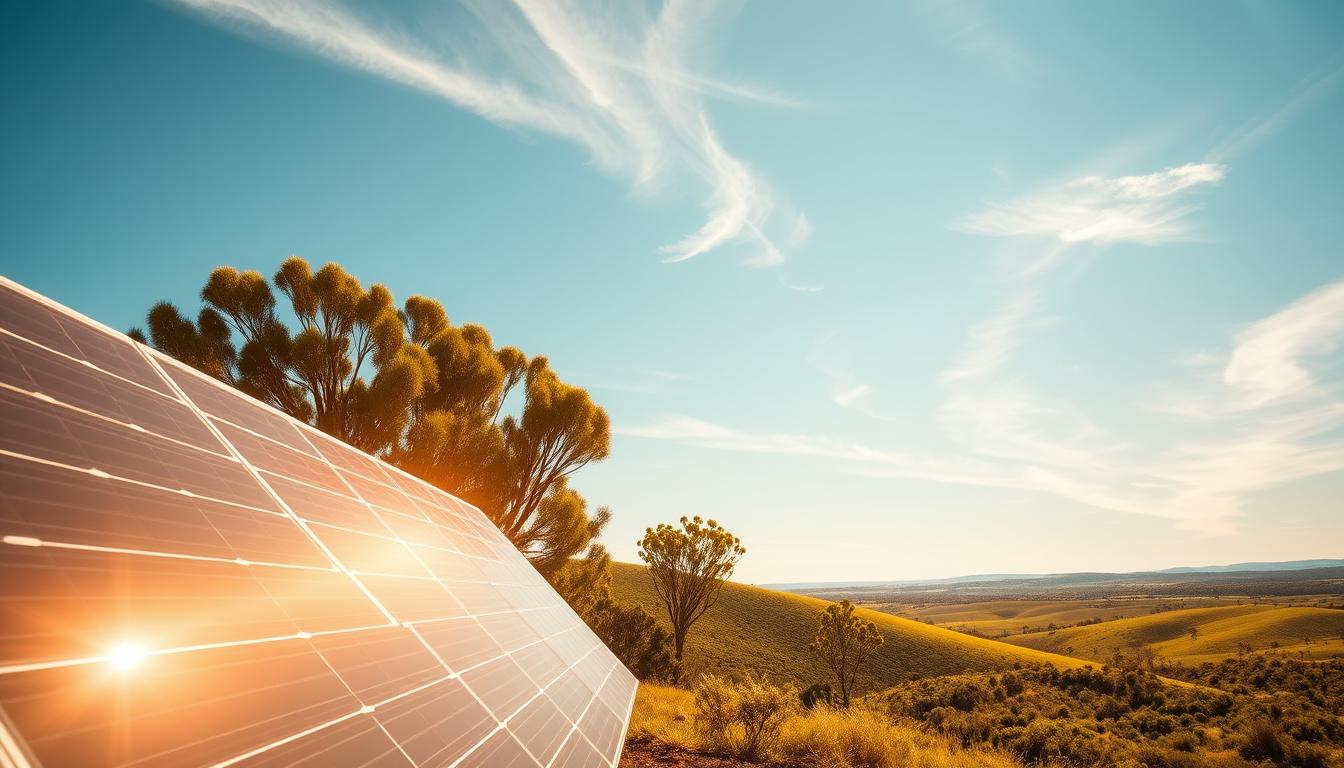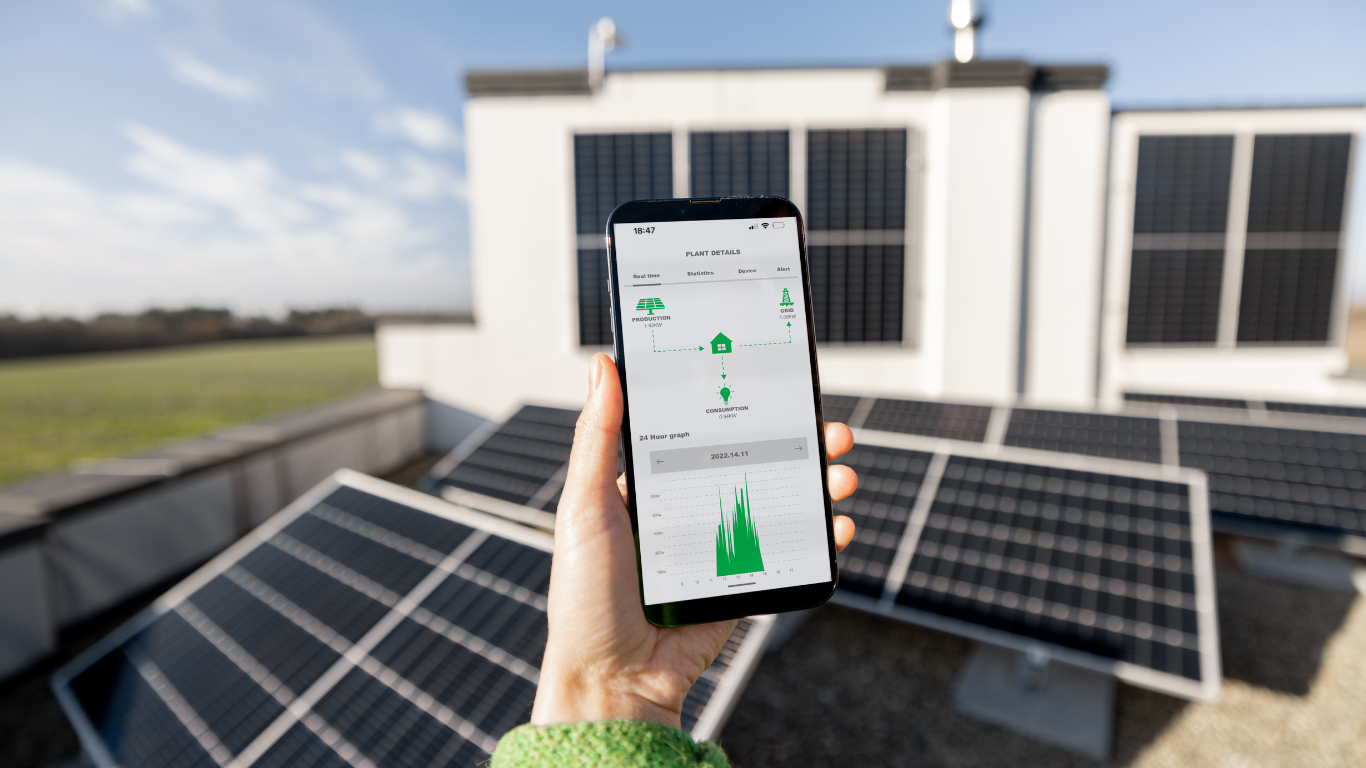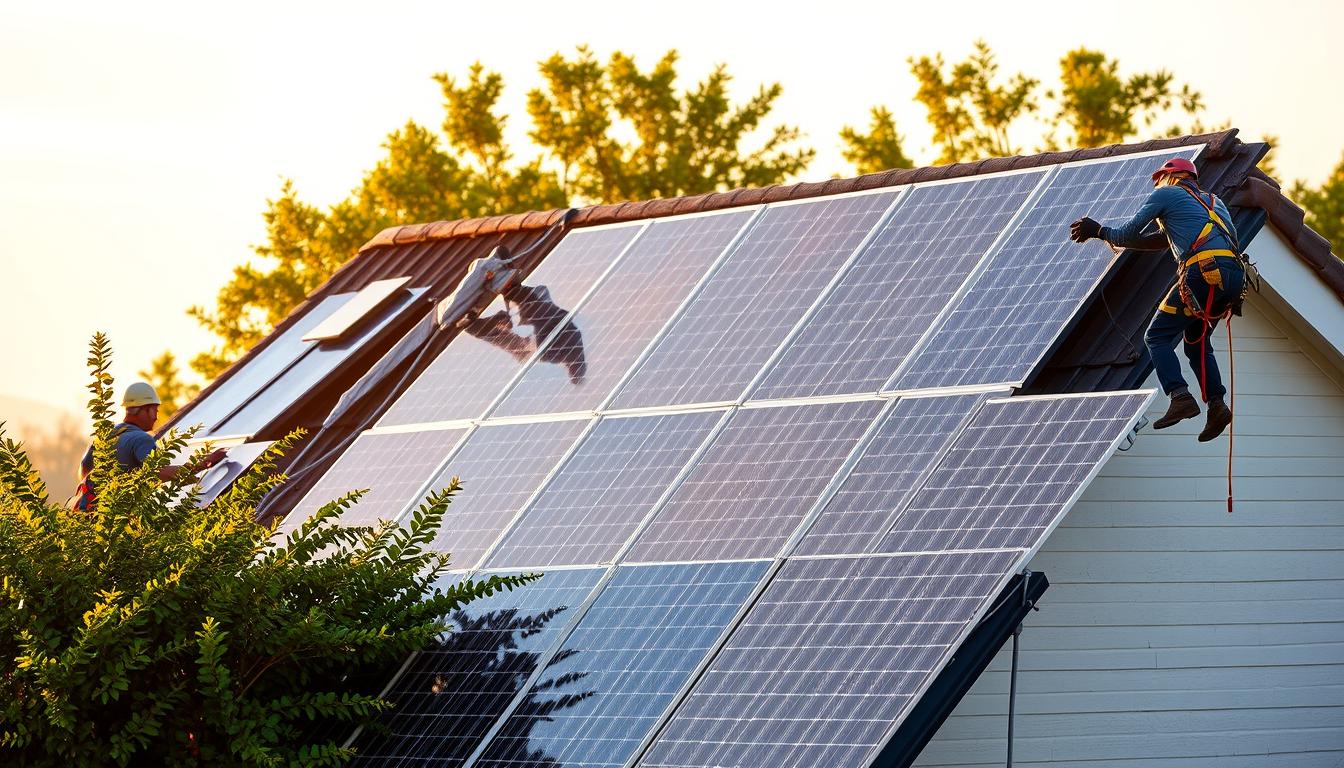Getting solar panels is a wise choice for Aussie homes. It cuts down on power bills and helps the environment. But, are you making the most of your solar system’s life? With the right care, your solar panels can last for decades, not just years.
They’re a big investment, and they need regular attention to work well. This care helps your system last longer and perform better.

The Australian weather is tough on solar panels. From hot summers to wild storms, they face a lot. Dust, debris, bird droppings, and sea salt can harm their performance.
By taking care of your panels now, you’ll save money later. You’ll avoid the cost of replacing them too soon.
Keeping your solar panels in top shape in Australia is easy. Simple cleaning and regular checks can make a big difference. With rising energy costs and climate worries, looking after your solar panels is crucial.
Key Takeaways
- Regular cleaning extends solar panel lifespan by up to 5-10 years
- Australian climate factors require region-specific maintenance approaches
- Professional inspections should occur every 2-3 years minimum
- Monitoring system performance helps catch issues before they become costly
- Proper maintenance preserves manufacturer warranties
- Most solar systems can last 25+ years with appropriate care
- DIY maintenance is possible but has important safety limitations
Understanding Your Solar System Investment
Buying solar energy is a big deal for Aussie homeowners. It’s not just the cost of setting it up. Knowing how it will pay off in the long run is key to getting the most out of it.
Average Lifespan of Solar Panels in Australia
Solar panels in Australia usually last 25-30 years. They don’t just stop working after their warranty ends. Instead, they slowly lose power, about 0.5-0.8% each year.
This means a good system can still work at 80-85% after 25 years. It’s a long-lasting investment.
Factors Affecting Solar Panel Durability
How long solar panels last depends on a few things. High-quality panels can handle Australia’s tough weather better than cheaper ones. Places near the sea face extra problems from salt, while inland areas deal with really hot and cold temperatures.
- Panel quality and manufacturing standards
- Installation workmanship
- Local weather patterns
- Maintenance frequency
- Mounting system integrity
| Location Type | Primary Durability Challenges | Expected Lifespan Impact |
|---|---|---|
| Coastal Areas | Salt corrosion, high humidity | -1 to -3 years |
| Inland Desert | Extreme heat, dust accumulation | -1 to -2 years |
| Temperate Regions | Minimal challenges | Standard lifespan |
Return on Investment Over Time
The time it takes to get back your money from solar panels depends on a few things. This includes how much electricity costs, feed-in tariffs, and how well your system works. Most homes in Australia start seeing savings in 4-6 years.
Keeping your system in top shape can make it last longer. A well-kept system can pay off 3-4 times your initial investment over 25+ years.
Keeping an eye on how well your system is working is important. A 10% drop in power can cost a lot of money each year. So, it’s worth checking on it regularly to save money.
How Australian Climate Affects Solar Panel Longevity
Australia’s climate varies greatly, affecting solar panels in different ways. The strong sun is great for solar energy but can also harm panels over time. Places like Queensland and the Northern Territory face very hot summers, which stress the panels even more.
Coastal areas have their own set of problems. In cities like Sydney and Perth, salt spray can damage the panels and their connections. This means they need special care to avoid early failure.
The weather’s effect on solar panels changes a lot depending on where you are. In tropical north Queensland, heavy rain can leave dirt on panels. In central Australia, dust can cut down their efficiency. Both need special cleaning to work well.
UV radiation is also a big worry for panels in sunny areas. The strong Australian sun is great for power but can damage panels over time. This can make them up to 20% less efficient if not managed right.
| Australian Region | Primary Climate Challenge | Impact on Solar Panels |
|---|---|---|
| Northern Australia | Extreme heat, humidity | Accelerated heat degradation, moisture ingress |
| Coastal Regions | Salt spray, sea air | Corrosion of components, connections |
| Central Australia | Dust storms, dry heat | Surface accumulation, heat stress |
| Southern States | Temperature fluctuations | Expansion/contraction stress on materials |
Temperature changes can also harm panels. In southern states, the big changes in temperature can weaken seals. Knowing these local issues helps homeowners keep their systems running longer.
Essential Maintenance Practices for Solar Panel Care
Keeping your solar panels in top shape is key to getting the most out of them. Proper care can increase energy output by up to 25%. The maintenance method depends on the type of panel and where you live in Australia.
Cleaning Techniques for Different Panel Types
Monocrystalline panels need soft brushes and mild soap for cleaning. Polycrystalline panels can handle a bit firmer brushing but avoid harsh materials. Thin-film panels require the softest touch with microfiber cloths to avoid damage.
Use rainwater when you can and steer clear of harsh chemicals that can harm the panels. Clean panels in the early morning or evening when they’re cool. This prevents damage from water and thermal shock.
Optimal Cleaning Schedule by Region
Coastal areas need cleaning every 2-3 months due to salt spray. Urban areas should be cleaned every 3-4 months to remove pollution and bird droppings. Rural areas need cleaning every month during dry seasons to remove dust.
In areas prone to bushfires, clean panels quickly after fires to restore function. Also, clean more often during pollen season if your panels are near trees or grasslands.
Safe DIY Maintenance Methods
Start with visual checks from the ground using binoculars to spot debris or broken glass. For cleaning, follow these safe steps:
- Clean on cool, overcast days to avoid slipping
- Use extension poles with soft brushes instead of climbing roofs
- Use minimal water, especially in dry areas, with spray bottles
- Check connections for corrosion or pests
- Keep records of maintenance with dated photos for warranty purposes
Never use pressure washers or abrasive tools that can scratch the panels. Always turn off systems before maintenance to ensure safety.
Signs Your Solar System Needs Professional Attention
Solar systems can face issues even with regular care. Spotting these problems early can prevent expensive fixes. It also keeps your system running at its best.
Common Performance Issues and Their Causes
Big drops in energy production often mean there’s a problem. This could be due to physical damage like tiny cracks or delamination. Or, it might be electrical issues like loose connections or bad wiring.
Inverter problems show up as error codes or when it just stops working. In coastal areas, salt can make things worse. Inland, dust can slowly cut down how well your system works.
When to Call a Certified Technician
If your system’s energy output drops by more than 25% from last year, get help. Also, if your inverter makes strange noises, lights flicker, or shows error messages, act fast.
Damage from storms or sudden shutdowns mean there’s something wrong. It’s also smart to have a pro check your system every year, especially if it’s over five years old.
Warning Signs of Potential System Failure
Discoloration or browning of panels can mean trouble ahead. If panels are bulging, it might be water getting in. And if you keep seeing error messages, it’s time to get help.
Quick action when you see these signs can help your system last longer. It also keeps your investment safe.
Protecting Your Solar Panels from Extreme Weather Events
Australian solar installations face big challenges from extreme weather. This can shorten their lifespan. To protect them, choose impact-resistant panels that match local weather conditions. Installations that go beyond the minimum wind-loading standards help defend against cyclones and severe storms.
Hail damage is a common issue in southeastern Australia. Professional installers can place panels at angles to reduce hail impact. They can also suggest specialized screens that let light through while blocking hailstones.
In cyclone-prone areas, solar panels need reinforced mounting systems and micro-inverters. These features limit damage during extreme weather. While they might cost more upfront, they save your system from major damage.
- Clear surrounding vegetation to reduce bushfire risks near panels
- Secure loose components before storm season
- Install water diversion channels to prevent flooding damage
- Document system condition regularly for insurance purposes
- Apply anti-soiling coatings to reduce dust buildup after storms
After a storm, it’s crucial to inspect your solar panels, even if they look fine. Look for tiny cracks, loose connections, and any drop in performance. Fixing small problems quickly stops them from becoming big issues. Keep good records of maintenance to support warranty and insurance claims if damage happens.
Solar System Monitoring: Tools and Technologies
Monitoring your solar investment is more than just looking at it sometimes. A good solar monitoring system gives you real-time info on how it’s doing. This helps find problems early, making your system last longer.

Smart Monitoring Systems Worth the Investment
In Australia, there are many great choices for keeping an eye on your solar. Enphase Enlighten, SolarEdge monitoring, and Fronius Solar.web are popular. They show how much power you’re making, compare what you expected to what you got, and spot issues before they get big.
| Monitoring System | Features | Price Range (AUD) |
|---|---|---|
| Enphase Enlighten | Panel-level monitoring, mobile app access | $400-600 |
| SolarEdge | Power optimizer integration, energy usage tracking | $350-550 |
| Fronius Solar.web | Weather integration, system comparison | $300-450 |
Interpreting Performance Data
To track your solar panels’ efficiency, you need to know what’s normal. A good system shows steady growth in power output during the day, peaking at noon. But if it drops suddenly or acts strangely, it might have a problem. Look for consistent output that matches the weather and the season.
Setting Up Alerts for Performance Drops
Make your solar monitoring system alert you when it’s not doing well. Most systems let you set up alerts based on your system’s size and where you live. Set up performance goals for different times of the year – like 4.2kWh/kW in winter and 5.8kWh/kW in summer in Australia. Alerts for big drops, over 15%, can catch problems early.
Ensuring Electrical Components Last as Long as Your Panels
Solar panels can last over 25 years. But, the electrical parts that support them don’t last as long. Your inverter, the core of your solar system, usually lasts 10-15 years if everything goes right. Keeping your inverter in good shape can make it last longer and avoid expensive problems.
Check all electrical parts of your solar system at least twice a year. Look closely at junction boxes, isolators, and where wires connect for signs of rust or heat damage. People living near the coast should check even more often because salt air can damage metal faster.
When it comes to wiring, make sure there are no cracks in the insulation, no pest damage, and all connections are tight. Loose wiring can make your system less efficient and is a safety risk. Also, keep electrical boxes clean and closed to stop animals like ants and geckos from making nests inside, which can cause short circuits.
Have a professional check your electrical system every two years. They can do tests that you can’t, like checking if everything is properly isolated and if the earthing connections are good. This is crucial for keeping your system running smoothly for a long time.
Keep records of all electrical work done on your system. This is important for warranty claims and to spot any patterns if problems start to show up. With the right care, you can make sure these important parts last as long as your solar panels.
Professional Maintenance Services: What to Expect and When to Schedule
Regular DIY maintenance is good, but professional checks are essential for top performance. Getting a solar panel maintenance service once a year can spot problems early. This saves you from expensive repairs later.
Finding Qualified Solar Technicians in Australia
When looking for a solar technician Australia wide, check for Clean Energy Council accreditation. These experts meet high standards and know how to keep your system in great shape. Local solar firms often have maintenance deals, but make sure they’re certified.
Typical Service Costs and Schedules
The price for professional solar cleaning and upkeep depends on your system’s size and where you live. Homes usually need a check-up every 12-24 months. Costs range from $150 to $300 for a basic check. If you live far from the city, you might pay more for the technician’s travel.
Many companies offer special deals for regular customers. This can help you save money over time.
What a Comprehensive Maintenance Check Should Include
A good solar panel maintenance service does several important things:
- It cleans the panels to get rid of dirt and debris.
- It checks the mounting brackets and frame to make sure they’re strong.
- It tests and tightens the electrical connections.
- It checks how well the inverter is working.
- It makes sure the system is calibrated right.
- It looks for any new shading issues.
Ask for a detailed report after the service. This report helps you keep track of your system’s health. It also proves your system’s condition if you need to make a warranty claim.
Upgrading and Retrofitting Older Solar Systems
As your solar installation gets older, it might not work as well as it used to. Many people in Australia who got solar systems early are now facing this problem. Upgrading your solar system can make it work better without the cost of a new one.

Adding new solar panels to your old system can save you money. It also brings in newer, more efficient technology. The biggest problem is usually with the inverters, which don’t last as long as panels. New microinverters can work with old panels, making your system better and lasting longer.
When thinking about updating your solar technology, consider these options:
- Replacing your inverter with a newer one for better efficiency and monitoring
- Adding more panels to use the space on your roof
- Getting a battery to store more energy
- Installing a smart system to track how well your solar is working
Deciding whether to upgrade or replace your system depends on its condition. If your panels are still working well, upgrading is a good choice. But if they’re not working as well or need expensive repairs, replacing them might be better. Getting a professional to check your system can help you decide what’s best for you.
Insurance and Warranty Considerations for Australian Solar Owners
It’s important to know how to protect your solar investment. Many Australians don’t read their solar panel warranty Australia documents until a problem arises. This can lead to expensive repairs that might have been covered.
Understanding Manufacturer Warranties
Solar panels usually have two warranties. The performance warranty lasts about 25 years and ensures your panels work at 80% of their capacity. The product warranty covers physical issues for 10-12 years. Australian Consumer Law also offers extra protection.
Home Insurance Coverage for Solar Systems
Standard home insurance might not fully protect your solar setup. Many find this out after damage from storms. Make sure your policy covers hail, wind, and electrical faults. Adding solar system insurance can offer full protection.
| Protection Type | Typical Coverage | Duration |
|---|---|---|
| Product Warranty | Physical defects, workmanship | 10-12 years |
| Performance Warranty | Power output degradation | 25 years |
| Home Insurance | Storm, fire, theft (varies) | Annual renewal |
Documenting Maintenance for Warranty Claims
Keep detailed records of maintenance for warranty claims. Photos, service receipts, and cleaning logs are key. Without these, many warranty claims are denied because owners can’t prove they followed maintenance guidelines.
Environmental Factors: Keeping Your Solar System Green for Longer
Solar power is clean energy, but we must care for our panels. Water is key in sustainable solar maintenance, especially in dry areas like Australia. Using rainwater for cleaning panels helps save water.
Choosing eco-friendly solar cleaning products keeps our soil and water safe. Biodegradable cleaners and soft tools are better for the planet. Many people clean their panels with just water and a soft brush, avoiding harmful chemicals.
The solar environmental impact goes beyond just using it. We must think about what happens when it’s no longer needed. Look for local recycling programs for solar panels. Australia is starting to recycle solar panels, saving materials like silicon and glass.
| Maintenance Aspect | Eco-Friendly Approach | Environmental Benefit |
|---|---|---|
| Water Usage | Rainwater harvesting, early morning cleaning | Water conservation in drought-prone areas |
| Cleaning Products | Biodegradable solutions, plain water | Prevents chemical runoff into ecosystems |
| End-of-Life | Recycling programs for components | Reduces landfill waste, recovers materials |
Good maintenance makes your system last longer and cuts down on carbon emissions. Every year your system runs saves the planet by using less resources.
Conclusion: Maximising Your Solar Investment Through Proactive Care
Looking after your solar panel maintenance is crucial. It helps keep your solar system running well for a long time. This way, you protect your solar investment and keep your home powered by clean energy.
Keeping your solar system in top shape is smart. It ensures your panels work efficiently and saves you money. Regular cleaning and checks can make your panels last longer. This means you’ll enjoy lower bills for many years.
By taking good care of your solar system, you’re doing your part for the planet. You’re saving energy and helping Australia move towards cleaner power. With the right care, your solar system will keep your home powered for years, showing your dedication to a sustainable lifestyle.
Frequently Asked Question
What are the average lifespan and efficiency degradation rates of solar panels in Australia?
Solar panels in Australia usually last 25-30 years. They lose about 0.5-0.8% efficiency each year. Keeping them clean can make them last longer and work better.
How do different Australian climate conditions affect solar panel longevity?
Australia’s weather can really affect solar panels. Hot weather in places like Queensland can make them degrade faster. Salt spray in Sydney and Perth can cause corrosion.
Heavy rain in the tropics and dust in central Australia need special care. This means different maintenance for different areas.
What are the essential maintenance practices for keeping solar panels in top shape?
Clean your panels right and follow a cleaning schedule based on your area’s weather. Use safe DIY methods for maintenance. The right care depends on the type of panel you have.
How can I tell when my solar system needs professional attention?
Watch for signs like hotspots, microcracks, and inverter failures. If you see any issues or a big drop in output, get a certified technician. They can fix the problem and keep your system running well.
What steps can I take to protect my solar panels from extreme weather events in Australia?
To protect your panels, secure loose parts, clear around them, and use covers. This helps against cyclones, hail, bushfires, and floods. Always check your system after bad weather and document any damage for insurance.
How can solar monitoring tools and technologies help extend my system's lifespan?
Smart systems give you data on how your system is doing. This lets you catch problems early. Set up alerts for drops in efficiency to keep your system running smoothly and last longer.
How can I ensure the electrical components of my solar system last as long as the panels?
Keep the electrical parts like inverters and wiring in good shape. Regular checks, cleaning, and local climate-specific care can help them last longer.
How can I ensure the electrical components of my solar system last as long as the panels?
Keep the electrical parts like inverters and wiring in good shape. Regular checks, cleaning, and local climate-specific care can help them last longer.
Don’t wait until your system underperforms.
Schedule a professional solar maintenance check today! Contact TMEC Services now to keep your solar panels running at their best.
According to Energy.gov.au, regular solar panel maintenance is crucial for ensuring maximum efficiency and longevity. They recommend cleaning panels, monitoring system performance, and scheduling professional inspections to keep your solar system running at its best.
By following these expert guidelines, you can extend your solar panel lifespan, reduce energy loss, and maximise your savings. Need professional solar maintenance? Contact TMEC Services today for expert care!

